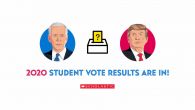 Since 1940, students in grades K–12 across the country have engaged in learning about civics and the democratic process through the Scholastic Student Vote, a mock election and time-honored educational tradition where kids and teens cast their vote for president of the United States.
Since 1940, students in grades K–12 across the country have engaged in learning about civics and the democratic process through the Scholastic Student Vote, a mock election and time-honored educational tradition where kids and teens cast their vote for president of the United States.
Eighty years ago in 1940, when headlines across the world were focused on World War II, Scholastic was as well as the Company kicked off the first-ever Scholastic Student Vote. In addition to being asked about the United States’ involvement in the war, students voted for president, choosing Franklin D. Roosevelt over Wendell Willkie. See photographs from the Scholastic archives, here!
Over the course of 20 United States presidential election cycles, the ScholasticStudent Vote results have mirrored the outcome of Election Day results, except three: Thomas E. Dewey vs. Harry S. Truman in 1948; John F. Kennedy vs. Richard M. Nixon in 1960; and Donald Trump vs. Hillary Clinton in 2016.
This election year, more than 168,000 votes were cast and students selected Democratic presidential candidate Joe Biden, with 61% of the Student Vote. Republican candidate President Donald Trump received 39% of the vote.
“Typically a student experiences two or three presidential elections as they’re growing up, and Scholastic helps teachers use the elections as powerful opportunities for students to learn about democracy. That’s why we created the Scholastic Student Vote in 1940—to more deeply engage students in this civics learning experience, to give them practice in exploring issues, having respectful discussions, and making their voices heard,” said Lauren Tarshis, Senior Vice President & Editor-In-Chief/Publisher, Scholastic Classroom Magazines.
“For 100 years, it’s been our mission at Scholastic to provide educators with the resources they need to support children in their journey to understand the world around them and to become critical thinkers.” According to findings from the Scholastic Teacher & Principal School Report: 2nd Edition, 92% of teachers agree that teaching students about the U.S. presidential election is an important way to help them become engaged and informed citizens.
To see the full results of the 2020 Scholastic Student Vote, and to access free resources such as videos about the democratic process, quizzes, activities, and Scholastic Kid Reporter stories, in addition to rigorously fact-checked candidate profiles and articles focused on issues at the center of this year’s election, visit: www.scholastic.com/election.



